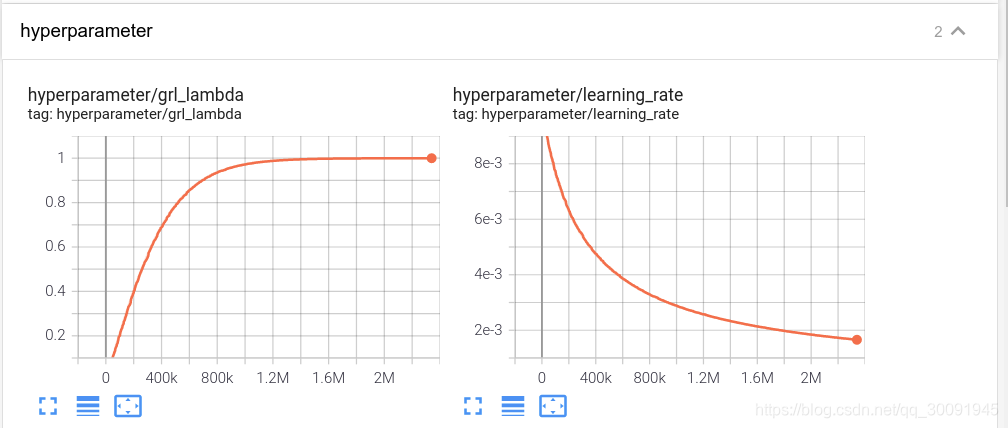前言
在前一篇文章【深度域自适应】一、DANN与梯度反转层(GRL)详解中,我们主要讲解了DANN的网络架构与梯度反转层(GRL)的基本原理,接下来这篇文章中我们将主要复现DANN论文Unsupervised Domain Adaptation by Backpropagation中MNIST和MNIST-M数据集的迁移训练实验。
一、MNIST和MNIST-M介绍
为了利用DANN实现MNIST和MNIST-M数据集的迁移训练,我们首先需要获取到MNIST和MNIST-M数据集。其中MNIST数据集很容易获取,官网下载链接为:MNSIT。需要下载的文件如下图所示蓝色的4个文件。

由于tensorflow和keras深度融合,我们可以通过keras的相关API进行MNIST数据集,如下:
from tensorflow.keras.datasets import mnist
# 导入MNIST数据集
(X_train,y_train),(X_test,y_test) = mnist.load_data()
MNIST-M数据集由MNIST数字与BSDS500数据集中的随机色块混合而成。那么要像生成MNIST-M数据集,请首先下载BSDS500数据集。BSDS500数据集的官方下载地址为:BSDS500。
以下是BSDS500数据集官方网址相关截图,点击下图中蓝框的连接即可下载数据。

下载好BSDS500数据集后,我们必须根据MNIST和BSDS500数据集来生成MNIST-M数据集,生成数据集的脚本create_mnistm.py如下:
# -*- coding: utf-8 -*-
# @Time : 2021/7/24 下午1:50
# @Author : Dai Pu wei
# @Email : [email protected]
# @File : create_mnistm.py
# @Software: PyCharm
from __future__ import absolute_import
from __future__ import division
from __future__ import print_function
import os
import tarfile
import numpy as np
import pickle as pkl
import skimage.io
import skimage.transform
from tensorflow.keras.datasets import mnist
rand = np.random.RandomState(42)
def compose_image(mnist_data, background_data):
"""
这是将MNIST数据和BSDS500数据进行融合成MNIST-M数据的函数
:param mnist_data: MNIST数据
:param background_data: BDSD500数据,作为背景图像
:return:
"""
# 随机融合MNIST数据和BSDS500数据
w, h, _ = background_data.shape
dw, dh, _ = mnist_data.shape
x = np.random.randint(0, w - dw)
y = np.random.randint(0, h - dh)
bg = background_data[x:x + dw, y:y + dh]
return np.abs(bg - mnist_data).astype(np.uint8)
def mnist_to_img(x):
"""
这是实现MNIST数据格式转换的函数,0/1数据位转化为RGB数据集
:param x: 0/1格式MNIST数据
:return:
"""
x = (x > 0).astype(np.float32)
d = x.reshape([28, 28, 1]) * 255
return np.concatenate([d, d, d], 2)
def create_mnistm(X,background_data):
"""
这是生成MNIST-M数据集的函数,MNIST-M数据集介绍可见:
http://jmlr.org/papers/volume17/15-239/15-239.pdf
:param X: MNIST数据集
:param background_data: BSDS500数据集,作为背景
:return:
"""
# 遍历所有MNIST数据集,生成MNIST-M数据集
X_ = np.zeros([X.shape[0], 28, 28, 3], np.uint8)
for i in range(X.shape[0]):
if i % 1000 == 0:
print('Processing example', i)
# 随机选择背景图像
bg_img = rand.choice(background_data)
# 0/1数据位格式MNIST数据转换为RGB格式
mnist_image = mnist_to_img(X[i])
# 将MNIST数据和BSDS500数据背景进行融合
mnist_image = compose_image(mnist_image, bg_img)
X_[i] = mnist_image
return X_
def run_main():
"""
这是主函数
"""
# 初始化路径
BST_PATH = os.path.abspath('./model_data/dataset/BSR_bsds500.tgz')
mnist_dir = os.path.abspath("model_data/dataset/MNIST")
mnistm_dir = os.path.abspath("model_data/dataset/MNIST_M")
# 导入MNIST数据集
(X_train,y_train),(X_test,y_test) = mnist.load_data()
# 加载BSDS500数据集
f = tarfile.open(BST_PATH)
train_files = []
for name in f.getnames():
if name.startswith('BSR/BSDS500/data/images/train/'):
train_files.append(name)
print('Loading BSR training images')
background_data = []
for name in train_files:
try:
fp = f.extractfile(name)
bg_img = skimage.io.imread(fp)
background_data.append(bg_img)
except:
continue
# 生成MNIST-M训练数据集和验证数据集
print('Building train set...')
train = create_mnistm(X_train,background_data)
print(np.shape(train))
print('Building validation set...')
valid = create_mnistm(X_test,background_data)
print(np.shape(valid))
# 将MNIST数据集转化为RGB格式
X_train = np.expand_dims(X_train,-1)
X_test = np.expand_dims(X_test,-1)
X_train = np.concatenate([X_train,X_train,X_train],axis=3)
X_test = np.concatenate([X_test,X_test,X_test],axis=3)
y_train = np.array(y_train).astype(np.int32)
y_test = np.array(y_test).astype(np.int32)
# 保存MNIST数据集为pkl文件
if not os.path.exists(mnist_dir):
os.mkdir(mnist_dir)
with open(os.path.join(mnist_dir, 'mnist_data.pkl'), 'wb') as f:
pkl.dump({
'train': X_train,
'train_label': y_train,
'val': X_test,
'val_label':y_test}, f, pkl.HIGHEST_PROTOCOL)
# 保存MNIST-M数据集为pkl文件
if not os.path.exists(mnistm_dir):
os.mkdir(mnistm_dir)
with open(os.path.join(mnistm_dir, 'mnist_m_data.pkl'), 'wb') as f:
pkl.dump({
'train': train,
'train_label':y_train,
'val': valid,
'val_label':y_test}, f, pkl.HIGHEST_PROTOCOL)
# 计算数据集平均值,用于数据标准化
print(np.shape(X_train))
print(np.shape(X_test))
print(np.shape(train))
print(np.shape(valid))
print(np.shape(y_train))
print(np.shape(y_test))
pixel_mean = np.vstack([X_train,train,X_test,valid]).mean((0,1,2))
print(np.shape(pixel_mean))
print(pixel_mean)
if __name__ == '__main__':
run_main()
二、参数配置类config
由于整个DANN-MNIST网络的训练过程中涉及到很多超参数,因此为了整个项目的编程方便,我们利用面向对象的思想将所有的超参数放置到一个类中,即参数配置类config。这个参数配置类config的代码如下:
# -*- coding: utf-8 -*-
# @Time : 2020/2/15 15:05
# @Author : Dai PuWei
# @Email : [email protected]
# @File : config.py
# @Software: PyCharm
import os
class config(object):
__defualt_dict__ = {
"pre_model_path":None,
"checkpoints_dir":os.path.abspath("./checkpoints"),
"logs_dir":os.path.abspath("./logs"),
"config_dir":os.path.abspath("./config"),
"image_input_shape":(28,28,3),
"image_size":28,
"init_learning_rate": 1e-2,
"momentum_rate":0.9,
"batch_size":256,
"epoch":500,
"pixel_mean":[45.652287,45.652287,45.652287],
}
def __init__(self,**kwargs):
"""
这是参数配置类的初始化函数
:param kwargs: 参数字典
"""
# 初始化相关配置参数
self.__dict__.update(self. __defualt_dict__)
# 根据相关传入参数进行参数更新
self.__dict__.update(kwargs)
if not os.path.exists(self.checkpoints_dir):
os.makedirs(self.checkpoints_dir)
if not os.path.exists(self.logs_dir):
os.makedirs(self.logs_dir)
if not os.path.exists(self.config_dir):
os.makedirs(self.config_dir)
def set(self,**kwargs):
"""
这是参数配置的设置函数
:param kwargs: 参数字典
:return:
"""
# 根据相关传入参数进行参数更新
self.__dict__.update(kwargs)
def save_config(self,time):
"""
这是保存参数配置类的函数
:param time: 时间点字符串
:return:
"""
# 更新相关目录
self.checkpoints_dir = os.path.join(self.checkpoints_dir,time)
self.logs_dir = os.path.join(self.logs_dir,time)
self.config_dir = os.path.join(self.config_dir,time)
if not os.path.exists(self.config_dir):
os.makedirs(self.config_dir)
if not os.path.exists(self.checkpoints_dir):
os.makedirs(self.checkpoints_dir)
if not os.path.exists(self.logs_dir):
os.makedirs(self.logs_dir)
config_txt_path = os.path.join(self.config_dir,"config.txt")
with open(config_txt_path,'a') as f:
for key,value in self.__dict__.items():
if key in ["checkpoints_dir","logs_dir","config_dir"]:
value = os.path.join(value,time)
s = key+": "+value+"\n"
f.write(s)
三、梯度反转层(GradientReversalLayer)
在DANN中比较重要的模块就是梯度反转层(Gradient Reversal Layer, GRL)的实现。GRL的tf2.x代码实现如下:
import tensorflow as tf
from tensorflow.keras.layers import Layer
@tf.custom_gradient
def gradient_reversal(x,alpha=1.0):
def grad(dy):
return -dy * alpha, None
return x, grad
class GradientReversalLayer(Layer):
def __init__(self,**kwargs):
"""
这是梯度反转层的初始化函数
:param kwargs: 参数字典
"""
super(GradientReversalLayer,self).__init__(kwargs)
def call(self, x,alpha=1.0):
"""
这是梯度反转层的初始化函数
:param x: 输入张量
:param alpha: alpha系数,默认为1
:return:
"""
return gradient_reversal(x,alpha)
在上述代码中@ops.RegisterGradient(grad_name)修饰 _flip_gradients(op, grad)函数,即自定义该层的梯度取反。同时gradient_override_map函数主要用于解决使用自己定义的函数方式来求梯度的问题,gradient_override_map函数的参数值为一个字典。即字典中value表示使用该值表示的函数代替key表示的函数进行梯度运算。
四、 DANN类代码
DANN论文Unsupervised Domain Adaptation by Backpropagation中给出MNIST和MNIST-M数据集的迁移训练实验的网络,网络架构图如下图所示。

接下来,我们将利用tensorflow2.4.0来搭建整个DANN-MNIST网络,DANN-MNIST网络结构代码如下:
# -*- coding: utf-8 -*-
# @Time : 2020/2/14 20:27
# @Author : Dai PuWei
# @Email : [email protected]
# @File : MNIST2MNIST_M.py
# @Software: PyCharm
import tensorflow as tf
from tensorflow.keras.layers import Dense
from tensorflow.keras.layers import Conv2D
from tensorflow.keras.layers import Flatten
from tensorflow.keras.layers import MaxPool2D
from tensorflow.keras.layers import Activation
def build_feature_extractor():
"""
这是特征提取子网络的构建函数
:param image_input: 图像输入张量
:param name: 输出特征名称
:return:
"""
model = tf.keras.Sequential([Conv2D(filters=32, kernel_size=5,strides=1),
#tf.keras.layers.BatchNormalization(),
Activation('relu'),
MaxPool2D(pool_size=(2, 2), strides=2),
Conv2D(filters=48, kernel_size=5,strides=1),
#tf.keras.layers.BatchNormalization(),
Activation('relu'),
MaxPool2D(pool_size=(2, 2), strides=2),
Flatten(),
])
return model
def build_image_classify_extractor():
"""
这是搭建图像分类器模型的函数
:param image_classify_feature: 图像分类特征张量
:return:
"""
model = tf.keras.Sequential([Dense(100),
#tf.keras.layers.BatchNormalization(),
Activation('relu'),
#tf.keras.layers.Dropout(0.5),
Dense(100,activation='relu'),
#tf.keras.layers.Dropout(0.5),
Dense(10,activation='softmax',name="image_cls_pred"),
])
return model
def build_domain_classify_extractor():
"""
这是搭建域分类器的函数
:param domain_classify_feature: 域分类特征张量
:return:
"""
# 搭建域分类器
model = tf.keras.Sequential([Dense(100),
#tf.keras.layers.BatchNormalization(),
Activation('relu'),
#tf.keras.layers.Dropout(0.5),
Dense(2, activation='softmax', name="domain_cls_pred")
])
return model
六、实验结果
下面主要包括了MNIST和MNIST-M数据集在自适应训练过程中学习率、梯度反转层参数 λ \lambda λ、训练集和验证集的图像分类损失、域分类损失、图像分类精度、域分类精度和模型总损失的可视化。
首先是超参数学习率和梯度反转层参数 λ \lambda λ在训练过程中的数据可视化。

接着是训练数据集和验证数据集的图像分类精度和域分类精度在训练过程中的数据可视化,其中蓝色代表训练集,红色代表验证集。训练精度是在源域数据集即MNIST数据集上的统计结果,验证精度是在目标域数据集即MNIST-M数据集上的统计结果。 由于RTX30显卡的精度高,MNIST和MNIST-M数据集的自适应训练的训练结果稳定在86%左右,比原始论文的81.49%精度高出不少也就在情理之中。

最后是训练数据集和验证数据集的图像分类损失和域分类损失在训练过程中的数据可视化,其中蓝色代表训练集,红色代表验证集。

后记
最初实现DANN使用tf1.x框架,后期发现由于GRL的特殊性,tf1.和GRL与复杂网络结构,如YOLO v3之间的适配度较低,因此现已将代码全面升到tf2.x,未如有需要也会支持pytorch。原始tf1.x的项目代码地址为:DANN-MNIST的tf1分支,tf2.x的项目代码地址如下:
- DANN-MNIST的tf2和master分支(tf2和master分支合并)
- DANN-MNIST-tf2
欢迎大家在CSDN和Github上一键三连